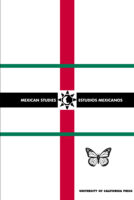The Ideals, Imaginaries, and Symbolisms of Hospital Nursing: A Q&A with Claudia Agostoni

Your article in the new issue of Mexican Studies/Estudios Mexicanos discusses the history of nursing in Mexico City in the 1940s and 1950s. What drew you to make a study of nursing in that particular time and place?
I am currently working on the social history of the hospitals that were built in Mexico City during the 1940s and 1950s. At that time, the expansion and modernization of general, specialized, and rural hospitals was a key priority of the postrevolutionary governments, which were trying to provide medical services for the first social security institute in Mexico, created in 1943, the Instituto Mexicano del Seguro Social (IMSS). This all required a numerous and well-trained health personnel, including nurses. However, an issue that troubled me was why the primary and secondary sources I consulted hardly ever referred to the nursing personnel; hospitals, then as now, cannot function without their work. In addition, nurses’ almost complete invisibility in written sources contrasted with their unending presence in numerous photographs of hospitals, sanatoriums, and clinics. Nurses also appeared in photos working in multiple public health activities beyond the hospital walls. These images were published in newspapers and journals, in official and institutional publications, in advertisements, and, in the film industry of Mexican Golden Age Cinema.
The article’s opening section has a fascinating discussion about nurses’ “immaculate” white uniforms and their symbolic importance. It reminded me of a nun’s habit. Is there a parallel?
The persistent image of the white uniform of the female nursing personnel, a symbol of commitment and professionalism that was (and is) easily recognizable by the public, did have important religious parallelisms. We have to remember that hospitals throughout the colonial period and well into the nineteenth century were charitable and religious institutions overseen by diverse Catholic orders, and that nurses, both male and female, wore the uniforms of their order when caring for the ill. Also, nursing was for a very long time inseparable from the idea of self-sacrifice, religious vocation, service, and spiritual calling. The historical processes whereby nursing was gradually transformed into a secular profession, running in parallel to the transformation of hospitals, hospital care, organization, and management, also transformed nurses’ uniforms. They had to be clean, simple, and neat; to denote respectability, discipline, morality, rectitude, and pureness, characteristics that were nurtured in religious, military and gender stereotypes, metaphors, and imaginaries.
What did the figure of Florence Nightingale mean in twentieth-century Mexico? Was there ever a “Mexican Florence Nightingale”?
Florence Nightingale was the symbol of the modern, professional, female, and respectable nurse not only in numerous European countries, Canada, and the United States but throughout most of Latin America. Mexico was no exception during the late nineteenth century and well into the twentieth century. I have not come across a “Mexican Florence Nightingale,” but if I do, I will definitively study that case.
Your article talks about how nursing in postrevolutionary Mexico was naturalized as a “feminine” and therefore politically docile occupation. Have things changed much?
Nursing was and still is widely perceived as a feminine and politically docile occupation, as an all-women’s occupation where low pay, long hours, rigid rules, and scant social and institutional recognition and support also seem to be naturalized. Even though the nursing profession has radically changed, the association of nursing with domestic work and caregiving tasks, as well as nurses’ immersion in the hierarchical structure of the hospital and of medical care, alongside the lack of institutional recognition and support, still persist. Nurses acquired remarkable visibility during the covid-19 pandemic; but once the pandemic ended, their invaluable work and demands were again forgotten.
Any good reading suggestions about this topic?
Numerous important studies have been published in the United States, Canada, and in diverse European and Latin American countries. For the specific case of Mexico, I suggest Elizabeth O’Brien, “‘If they are useful, why expel them?’ Las Hermanas de la Caridad and Religious Medical Authority in Mexico City Hospitals, 1861–1874,” Mexican Studies/Estudios Mexicanos 33, no. 3 (2017): 417-442, which examines with great care and originality the political, scientific, and medical motives that led to the Hermanas’ expulsion in 1874. On nurses’ uniforms and their symbolism, I strongly recommend Jane Books and Anne Marie Rafferty, “Dress and Distinction in Nursing, 1860-1939: ‘A Corporate as well as Corporeal Armour of Probity and Purity,’” Women’s History Review, 16, no. 1 (2007): 41-57, and Adrián Cammarota, “Maestras y enfermeras: entre el cuidado y la enseñanza,” in Karina Inés Ramacciotti (ed.), Historia de la enfermería en Argentina: pasado y presente de una profesión (Buenos Aires: Edunpaz, Colección Horizontes, 2020), 485-519. Also, on the history of visiting nurses in postrevolutionary Mexico: Claudia Agostoni, “Las mensajeras de la salud. Enfermeras visitadoras en la ciudad de México durante la década de los 1920,” Estudios de historia moderna y contemporánea de México 33 (2007): 89-120. And on the images and imaginaries of nurses and physicians in Mexican cinema, a must-read is Julia Tuñón, Cuerpo y espíritu: medicos en celuloide (Mexico City: Secretaría de Salud, 2005).

We invite you to read Claudia Agostoni's article "La suavidad revela la grandeza: la enfermería en los modernos hospitales de la Ciudad de México a mediados del siglo XX" for free online for a limited time.
Print copies of the Summer 2025 issue of Mexican Studies/Estudios Mexicanos (issue 41.2), in which the article appears, as well as other individual issues of MS/EM, can be purchased on the journal’s site.
For ongoing access to MS/EM, please ask your librarian to subscribe and/or purchase an individual subscription.
